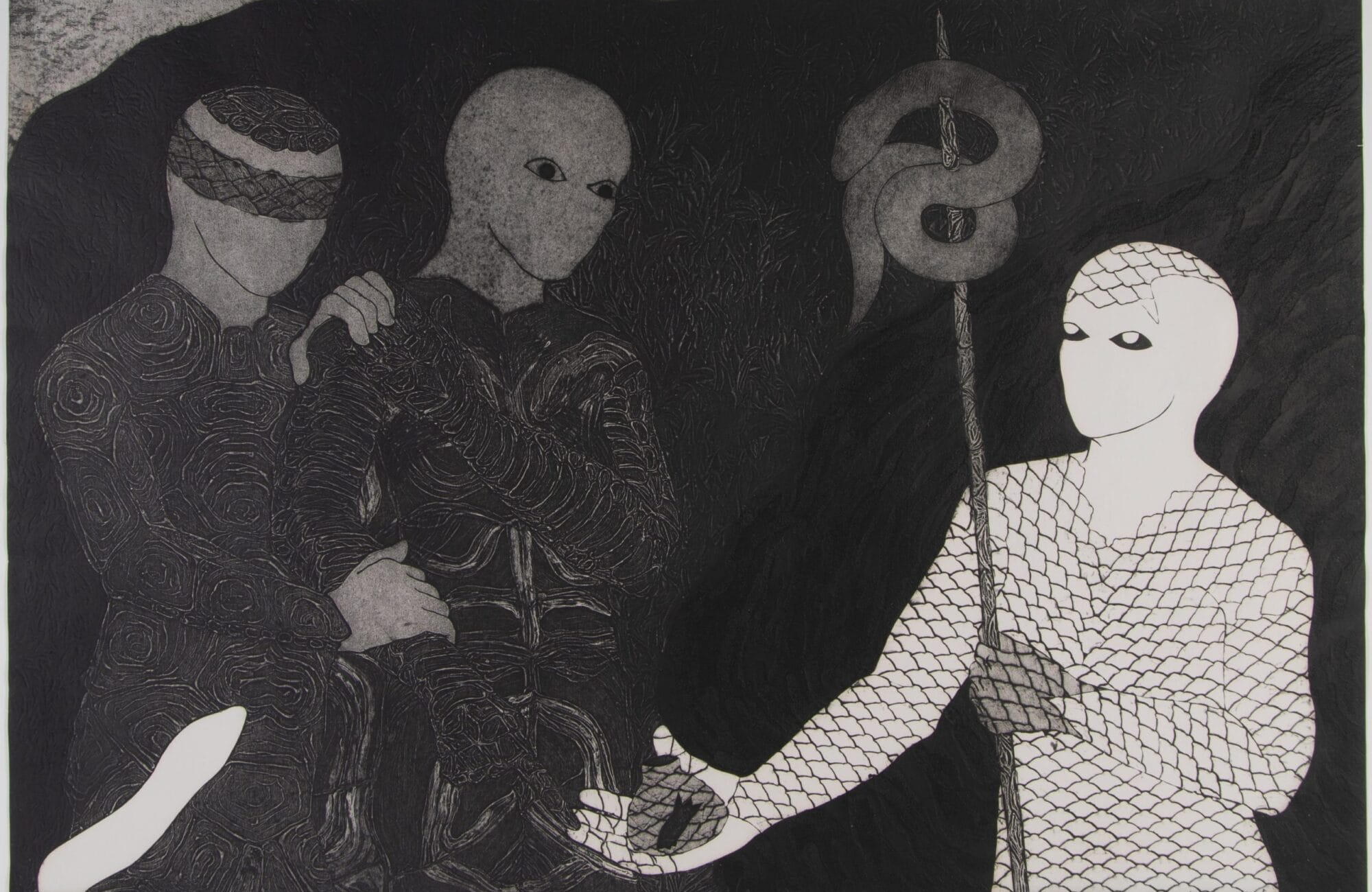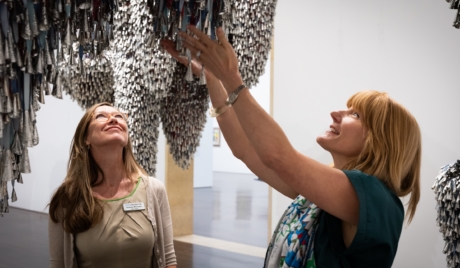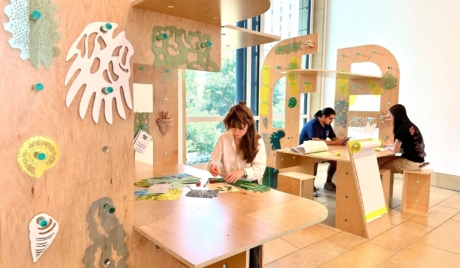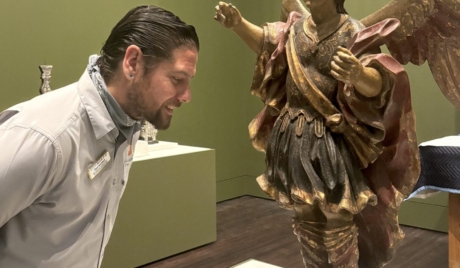
by Catalina Cherñavvsky Sequeira, 2022-2023 Andrew W. Mellon Fellow in Prints and Drawings, Blanton Museum of Art
Three years ago, the Blanton acquired Vamos (Let’s Go) by the prolific Cuban printmaker Belkis Ayón (1967-1999). This was the second work by the artist to enter the museum’s collection and the first in her signature technique, collagraphy. Ayón started her printmaking practice at a young age, creating linocuts, woodcuts, engravings, lithographs, and collagraphs. By the time she was twenty-four, she had participated in over thirty group shows and biennials and was a prominent figure in the promotion of contemporary Cuban art internationally. After her untimely death at age thirty-two, her artwork regained significant attention with an exhibition that traveled across the U.S. from 2016 to 2018. A display of her prints was also featured in the entrance of the Arsenale pavilion at the Venice Biennale in 2022, where she had exhibited in her mid-twenties in 1993. Today, her work continues to be showcased in solo exhibitions around the world.
During my time as a fellow in the Prints & Drawings department, I took a deep dive into Vamos to uncover the specific techniques Ayón utilized and to figure out a way to present those findings to museum visitors in an engaging way. Undertaking a year-long study of the artist’s printmaking process, I traveled to various public and private collections across the United States that house her collagraphs and spoke to artists and collectors who had worked with Ayón. I also collaborated with artist and UT professor of print practice Enrique Figueredo to recreate a modest, scaled-down replica of Vamos that museumgoers were encouraged to look closely at and touch, inspiring alternate ways of experiencing the artwork. We documented the fascinating process of creating the collagraph which is available for viewing on the Blanton’s YouTube page. Examining Ayón’s works through this technical approach left me further in awe of the artist’s skill. I am amazed at how she created distinct outlines and intricate patterns while also conveying the illusion of drawing or painting through print. The precise fit of her collaged elements makes her collagraphs seem like intricate puzzles, constructed with incredible care and patience. Ayón’s use of collagraphy evokes the intimacy and tactility inherent in the printmaking process, and brings those qualities to the surface for viewers.
Beyond her unparalleled printmaking skills, one reason for Ayón’s early fame is the imagery she chose to depict. Ayón began researching abakuá in secondary school and from then on made it the primary subject of her work. Abakuá is an all-male Afro-Cuban secret society that arrived in Cuba from Nigeria in the early 19th century as a result of the slave trade. Before Ayón created a visual language for the confraternity, knowledge about the abakuá was primarily passed down through oral histories and written historiographies.
In Vamos, Ayón focuses on Sikán, a foundational figure in abakuá lore who became a quintessential feature in many of Ayón’s prints. Her white skin, a color that signifies death, is covered in scales, just like the fish she holds in her hand. According to the origin story, Sikán accidentally traps a fish named Tanze while collecting water from a river. Tanze is the reincarnation of a deified king named Ekoi, whose voice holds the sacred secret of abakuá. It was believed that whichever tribe obtained the secret of abakuá would be the richest and most prosperous. Like most myths, there are different versions of Sikán’s demise. One account says that Sikán is killed because she shares the secret of Tanze with her lover in an enemy tribe, causing women to be henceforth banned from the confraternity. An alternative iteration claims that members from another tribe found Sikán and sacrificed her in hopes of attaining the sacred secret that they believed had been transferred from Tanze’s skin to her own. This helps explain why she appears covered in scales in Vamos. The snake on the lefthand side and atop Sikán’s spear is a motif that shows up throughout many of Ayón’s works, at times as a threatening presence and other times as a protective one. According to legend, the snakes are sent to the scene by an abakuá diviner to figure out what has happened to Tanze. The two figures to the left of Sikán are unidentified, though the blindfolded character represents someone who is being initiated into abakuá prior to entering the Fambá (sacred room). These two people may be from the neighboring tribe, or from her own. Sikán’s complicated character as both principal figure and traitor in abakuá history is a theme Ayón explores in depth in her oeuvre.
In addition to centering her works on a marginalized confraternity, Ayón utilized an unusual printmaking practice not generally taught in art school. Collagraphy is a technique in which an image is collaged onto a plate or matrix, rather than being carved, as in woodcut, or drawn, as in lithography. Materials glued onto the matrix can create an endless variety of texture, producing both intaglio and relief within the same print. This unconventional process was relatively new in Cuba when Ayón took it up. Collagraph plates are most often produced using everyday materials and found objects, making it an accessible technique. Some scholars claim that Ayón’s turn to collagraphy was a necessary one, as Cuba experienced intense economic turmoil after the fall of the Berlin Wall in 1989, losing access to essential imports from Eastern Europe. Even paper and ink became hard to find. While this scarcity certainly could have been a factor in Ayón’s choice to practice collagraphy, it was by no means the only reason. Shortly after finishing her studies, Ayón became a professor of printmaking at her former secondary school, San Alejandro Academy, where she likely had access to studios and materials to continue her work in woodcut, linocut, and engraving. Thus, the decision to make her primary practice collagraphy was a pointed one.
Ayón felt that collagraphy allowed her to more easily work in large formats, which she preferred, and she delighted in the fabrication process. She felt that the ethos of her works could not be adequately expressed through other printmaking methods or through painting. To construct her collagraphs, Ayón used materials like cardstock of different weights and absorbency, sandpaper, dried leaves and vegetable peelings, gesso, and carborundum. By drawing designs in wet gesso, Ayón imbued her images with an organic and painterly effect. She often mixed carborundum, a gritty material originally used to smooth out lithography stones, with an adhesive to produce sand-like textures. Early in her career, Ayón largely abandoned color because she felt black and white best emphasized the figure of Sikán and the other characters in her scenes. The materials Ayón used on her cardboard plates deteriorated quickly, so she had a strict rule of limiting her edition size to six impressions. To her frustration, she sometimes had to double her edition size to meet consumer demands. Her reduced edition size safeguarded the construction and consistency of her prints, or “multiple originals” as she called them.
Because of Ayón’s passing at a young age and at the height of her career, there is a lot of speculation about her artistic decisions. Researchers have hypothesized on her reasons for using collagraphy and for her obsessive examination of abakuá throughout so many years. Just as some scholars have claimed that Ayón’s reasons for taking up collagraphy were out of material necessity, many also read her chosen subject matter as an allusion to issues of gender and racial identity in Cuba at the time, though in interviews Ayón asserts there are no racial undertones in her works based on her own biography. However allegorical her pictorial language may have been, the enigmatic society of abakuá was the conduit through which Ayón could adequately express her artistic vision. Similarly, collagraphy was an underdeveloped printmaking method that Ayón chose to celebrate and master. For her, collagraphy was the most fitting technique for what she wanted to express. The complex patterns and remarkable tonal variance Ayón achieved through collagraphy continue to be among the most beautiful and technically impressive examples of the process.
Related Posts
Funding the Future of Art through the 2025 Blanton Gala

MAKEwild: Unleash your creative wild side

Appreciating Art as a Mestizo American

